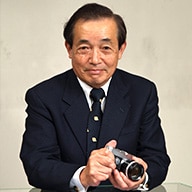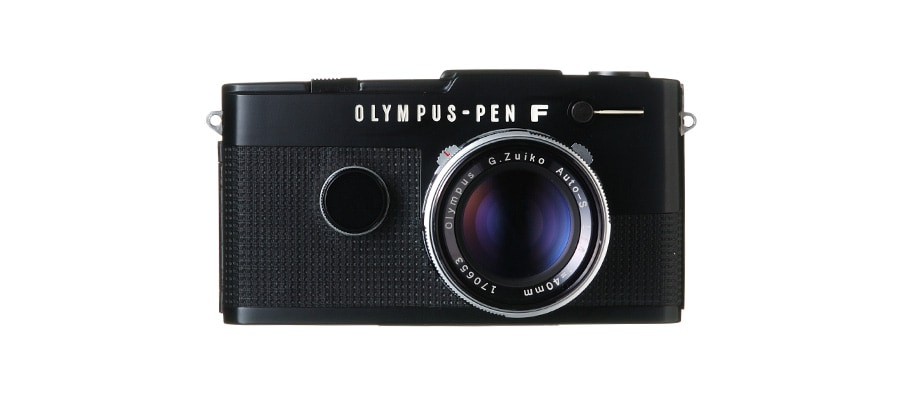If the development staff can give 120% of their power, the technology barrier can be overcome. But make sure your original and interesting ideas are not buried under the barrier of accepted wisdom. An engineering philosophy that called for the development of cameras based on totally new ideas led to the creation of the OM Series, and to the development of a caseless compact camera that won a Good Design Grand Prize. These achievements also helped to build a culture of originality that is part of the Olympus tradition.
From a seminar presented at the JCII Camera Museum on Saturday, November 26, 2005 The Olympus Story – From the Olympus OM-1 to the XA Series
(Planning and editing: Olympus Web Strategy Group)

OM-1

Profile of Yoshihisa Maitani
Yoshihisa Maitani was born in 1933. Since boyhood, he felt an affinity toward cameras and photography. After studying mechanical engineering at university, he joined Olympus Optical Co., Ltd. (now Olympus Corporation) in 1956. As a camera designer, he was involved in the development of many cameras that triggered major booms and became milestones in world camera history, including the Olympus Pen (1959), the Olympus Pen F (1963), the Olympus OM-1 (1973) and the Olympus XA (1979). He dies at the age of 76.
We had created the Pen FT, the world's first half-size TTL SLR camera, but...
Thank you for coming here today for the second lecture of this series. In the first session I spoke about Olympus' early camera-related activities between the 1920s and the introduction of the Pen F. Today I will talk mainly about cameras that I designed, from the OM-1 to the OM-4, and also the XA.
The Pen F was launched in 1963. In 1966 we put the Pen FT and the Pen FV on the market. This is where my previous presentation ended. It was around this time that we began developing a 35mm SLR. With an SLR, it isn't enough just to produce a body. You also need exchangeable lenses and other accessories. It takes a lot of time to complete a system.

Olympus Pen F
It was in 1966 that we perfected the Pen FT, the world's first half-size TTL SLR. We had completed the camera, and now we were under intense pressure from users. In the midst of that struggle, I was asked to develop a 35mm SLR. I considered refusing because I was so busy with the Pen....

Olympus Pen FT
To understand why Olympus wanted to make a 35mm SLR you need to understand the social situation in Japan at that time. Japan was experiencing a mild recession in the aftermath of the Tokyo Olympics and cameras were not selling well on the domestic market, so we needed to focus on overseas sales. Unfortunately, Kodak refused to support the half-size concept because the film mounts would cost twice as much. A “no” from Kodak meant that we couldn't sell our cameras in America. However, Agfa agreed to produce the mounts, and we enjoyed excellent sales in Germany and the Netherlands.
Japanese manufacturers were happy to support us because the half-size camera was made in Japan. This attitude of helping each other was a driving force for Japan's industrial development. Fuji and Konishi both produced half-size mounts, and so did Agfa. Only Kodak refused, which meant we couldn't sell our cameras in America. However, the executive in charge of exports to America refused to accept this. He told me that we must meet our quota, and the only way to do that was to make a 35mm SLR.
After creating half-size cameras, Olympus commits to the development of a 35mm SLR.

Photography was the starting point for everything I did. Whether the camera was a half-size or an SLR, my sole concern was that it could take good photographs. Though Olympus wanted to make a 35mm, I didn't feel that I had to do it, because SLRs were already on the shelves in camera shops for everyone to buy.
In fact Olympus was already developing a 35mm SLR when the Pen boom was at its height. They had completed research and design and were close to starting production. It clashed with the Pen F project, and Olympus had to decide which project should take priority. In the end, they decided to move ahead with the Pen F because of the profile Olympus had built as a manufacturer of half-size cameras.
I thought we could simply restart the existing 35mm SLR development project, but it wasn't that easy. I had started out using a Leica, and my enthusiasm for photography was such that I had even had pictures published in magazines. So I told the sales people that I didn't see any gap that needed to be filled, and that there was no need for me to make the camera. They replied that the new camera could be just the same as those made by other manufacturers, but I thought exactly the opposite. I wanted to make something that didn't exist. They said it was fine to make something that was the same as existing products. They even said we could buy it!
However, Japan was about to enter its period of rapid economic growth and manufacturing was seen as a crucial activity, so my attitude was unthinkable in that context. Manufacturing know-how was vital. By outsourcing production or buying in products from other manufacturers, companies risked losing their know-how. There were even movies about industrial espionage.
Yet the sales people were happy with that approach. They said it would be quicker. I asked them if a user would choose a Nikon or a Pentax or a camera sold by Olympus that was the same as these cameras, for I would certainly have bought the original products. But the sales people said that it was fine. I was completely perplexed!






